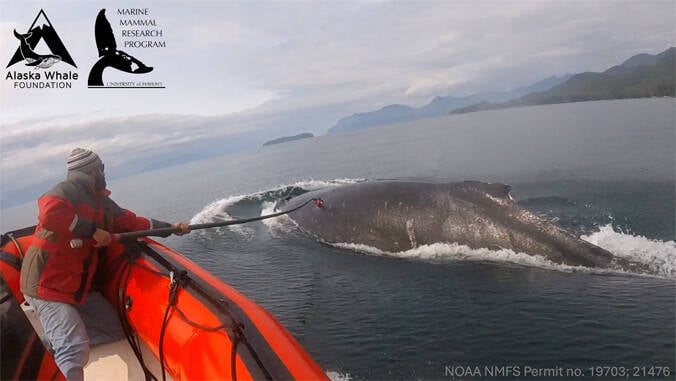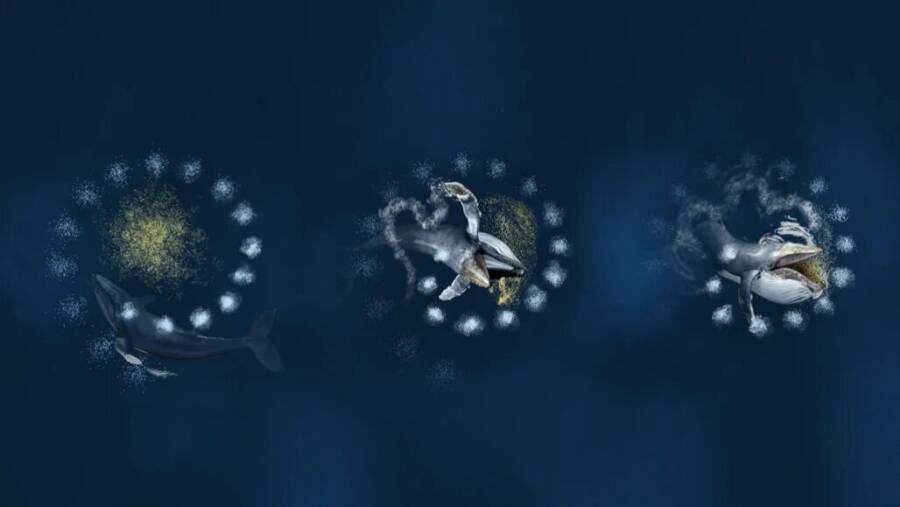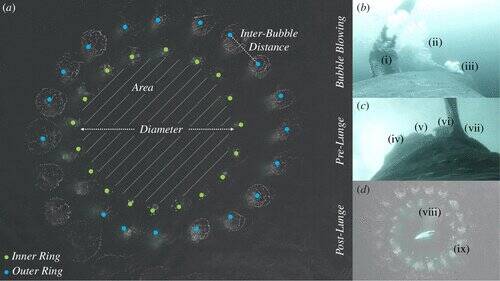These new findings have added humpback whales to the short list of animals that manufacture and use their own tools.

UnsplashA humpback whale breaching.
For years, researchers knew that humpback whales used an ingenious hunting technique called “bubble netting.” These creatures blow air bubbles in patterns to trap and confuse their prey, essentially creating their own version of a net.
Now, a recent study from the Hawaiʻi Institute of Marine Biology and the Alaska Whale Foundation has just found that humpback whales not only use bubble netting to catch krill and other prey, but they also actively modify these nets in response to different hunting conditions.
Researchers say this skill demonstrates the use and manipulation of “tools,” earning humpback whales a spot on the elite list of tool-wielding creatures in the animal kingdom.
Researchers Explore Humpback Whales’ Tool Making Abilities

MMRP/AWFA researcher places a suction cup tag on a humpback whale to track its movements.
Beginning on July 14, 2019, researchers from the Hawaiʻi Institute of Marine Biology and the Alaska Whale Foundation (AWF) traveled to Frederick Sound and lower Stephens Passage in Southeast Alaska to study humpback whales’ hunting behaviors.
Researchers already knew that humpback whales employed the use of “bubble nets,” but they were astonished to discover that the whales skillfully manipulated the nets as they hunted.
“Many animals use tools to help them find food, but very few actually create or modify these tools themselves,” Lars Bejder, co-lead author of the study and Marine Mammal Research Program (MMRP) director at the UH Hawaiʻi Institute of Marine Biology, stated in a press release.

K. Kosma / Royal Society Open Science 2019Humpback whales blowing bubble nets to catch krill.
The researchers began their study by tagging the whales with special suction cup tags. Then, they used drones to follow and document them.
“We deployed non-invasive suction-cup tags on whales and flew drones over solitary bubble-netting humpback whales in Alaska, collecting data on their underwater movements,” William Gough, co-author and MMRP researcher, stated in the press release. “The tools have incredible capability, but honing them takes practice. Whales are a difficult group to study, requiring skill and precision to successfully tag and/or drone them.”
The footage showed a remarkable sight.
“We discovered that solitary humpback whales in southeast Alaska craft complex bubble nets to catch krill,” Bejder said. “These whales skillfully blow bubbles in patterns that form nets with internal rings, actively controlling details like the number of rings, the size and depth of the net, and the spacing between bubbles. This method lets them capture up to seven times more prey in a single feeding dive without using extra energy.”
Humpback Whales Join The Elite List Of Tool-Wielding Animals

Szabo et al. / Royal Society Open ScienceResearchers document the structure and size of the bubble nets.
The study presents a convincing case for humpback whales’ use of tools in the wild.
For decades, researchers wondered how these massive whales could obtain enough calories to fuel their migrations across the Pacific Ocean. Now, their demonstrated toolmaking skills provides insight into how the whales are able to survive in food-scarce environments.
“This is a rich dataset that will allow us to learn even more about the physics and energetics of solitary bubble-netting,” said Bejder. “There is also data coming in from humpback whales performing other feeding behaviors, such as cooperative bubble-netting, surface feeding, and deep lunge feeding, allowing for further exploration of this population’s energetic landscape and fitness.”
With about a quarter of the 92 species of cetacean, a group of animals that includes whales and dolphins, at risk of extinction due to factors like habitat degradation, pollution, and climate change, it is more important than ever to discover how these creatures thrive. With these most recent findings, researchers can better craft conservation plans to aid their foraging behaviors.
“What I find exciting is that humpbacks have come up with complex tools allowing them to exploit prey aggregations that otherwise would be unavailable to them,” Andy Szabo, AWF executive director and study co-lead, stated in the press release. “It is this behavioral flexibility and ingenuity that I hope will serve these whales well as our oceans continue to change.”
After reading about humpback whales’ use of tools, dive into the story of Alex, the brilliant parrot who helped scientists understand bird cognition. Then, read about the 29 strangest animals on planet Earth.





